Bruce Tuckman's 'Stages for a Group'
Much of the theory of team motivation is based on academic research and has its roots in both psychology and sociology. It began with the work of Wilhelm Wundt (1832-1920), who is credited as the founder of experimental psychology. It was Kurt Lewin (1890-1947), a social psychologist, who coined the phrase 'group dynamics' to describe the positive and negative forces within groups of people.
In 1945, Lewin established The Group Dynamics Research Center at the Massachusetts Institute of Technology, the first institute devoted explicitly to the study of group dynamics and how it could be applied to real-world, social issues.
As research continued in this area throughout the second half of the twentieth century its focus moved more into studying how group performance could be improved in the workplace.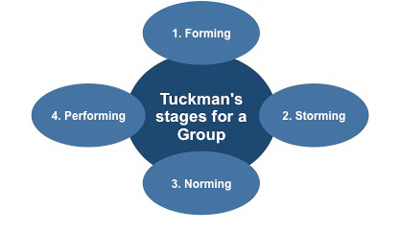 |
One of the most influential studies in this area is Bruce Tuckman's (1965). He proposed the four-stage model called 'Tuckman's Stages for a Group,' which states that the ideal group decision-making process should occur in four stages:
1. Forming
2. Storming
3. Norming
4. Performing
Tuckman maintained that these phases are all necessary and inevitable in order for the team to grow, to face up to challenges, to tackle problems, to find solutions, to plan work, and to deliver results.
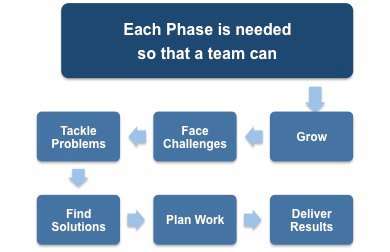 |
This model has become the basis for subsequent models and it is important to understand the process of each stage and its concepts so that you can apply it to your workplace.
Stage 1 - Forming
This first stage involves the bringing together of a group of individuals to form a team. At this stage, members usually have positive expectations about the venture, although they may harbor some anxiety about other members, such as who they are and what they are like.
At this point it is about building relationships within the group and clarifying the team's mission. Initially individuals behave independently of each other, but as they gather information and impressions about:
• Each other,
• The scope of the task,
• Its challenges and opportunities, and
• How to approach it
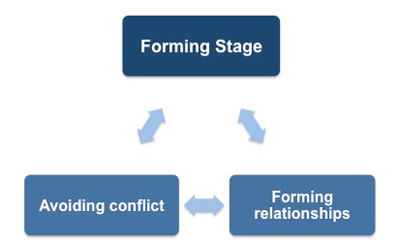 |
Each individual's behavior is driven by a desire to be accepted by the other team members and to avoid conflict. This results in serious issues being avoided, or put off, as team members concentrate on non-contentious or routine issues.
This reluctance to engage in and resolve areas of conflict means that the team accomplishes very little and the underlying differences which have been brushed aside will eventually surface and have to be addressed.
The length of this first stage will depend on how clearly the task is defined and on how much experience the individuals have of working in a team. Groups with simple tasks will move through orientation quickly, but groups with complex goals and tasks may spend much longer in this stage.
Teams made up of people who are used to being autonomous will take longer to build the necessary relationships for a successful team than those used to working in a group. Many individuals may be reluctant to contribute at this stage and their support of the leader is given cautiously.
As a manager you need to be very 'hands on' at this stage, giving clear directions and structure to make sure that your team build strong relationships. You can facilitate this by making sure your communications dispel any misunderstandings that could arise about roles and responsibilities.
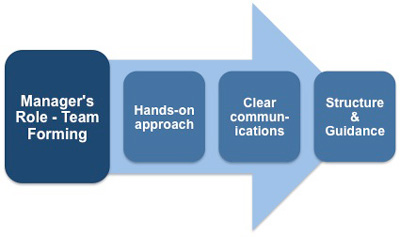 |
With decisions being made in the majority of cases by the nominated leader you also need to ensure that no team member is committing themselves to do too much, or too little, of the planned work.
By paying attention from the outset to building good relationships, as well as focusing on a clearly defined task, your team will perform better than teams whose managers rush through or skip over the relationship-building stage.
Stage 2 - Storming
During this second stage, where team members feel more able to express and question opinions, you will see more evidence of internal conflict. Your role as manager is to contain and direct this energy into a productive channel. You need to be aware that some level of internal conflict will cause a simultaneous dip in team morale.
Your management role will have to become more supportive, guiding the team in their decision-making and offering explanations of how these decisions came about. You need to define what you and the organization expect of the team in terms of professional behavior.
This more instructional approach will enable you, as team manager, to prevent any conflict from getting out of control and poisoning relationships between team members.
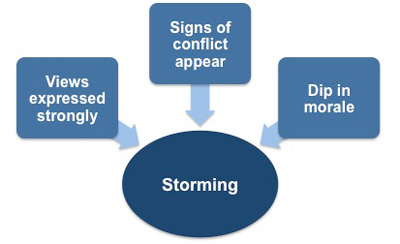 |
You will be able to recognize when your team moves into the 'storming' stage because you will observe your team beginning to address the differences between their initial perceptions and the reality of the situation that they have been formed to address. This will cover issues such as what problems they are really supposed to solve, how they will function independently and together, and what leadership model they will accept.
As your team members begin to negotiate the work assignments and express their views on the best way to achieve the task outcome disagreements will arise. Through your active listening skills you will mediate and help decisions to be made through compromise as the most efficient way to attain the necessary outcomes.
While your team members confront each other's ideas, test differing perspectives, discuss what the group needs to do, and how best to accomplish it, your role becomes one of a facilitator building trust within sub-groups of the team.
Team storming, whilst it may be contentious and unpleasant, will be resolved relatively quickly with your guidance and support. You must view this as a necessary step for your team to become a cohesive whole, not as an enormous irritation to be dismissed.
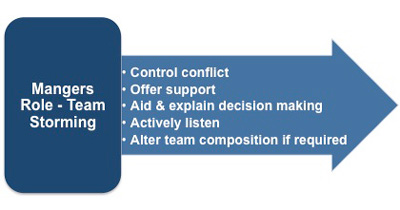 |
As a manager you need to be mindful of how this 'conflict' affects your team members and coach them in developing their own coping strategies. For example, some individuals may:
• Find this stage painful because they are averse to conflict.
• Feel anger or frustration with the task or with other members.
• Resent the presence of formal leadership.
• Focus on minutiae to avoid the real issues confronting the team.
The maturity in terms of attitude and approach to problem resolution of some team members can be significant in determining whether your team will ever move out of this stage.
If you try to bulldoze through this stage in your team's development you may find it becomes a permanent state, resulting in low morale and lack of productivity. If you fear this is happening to your team you will need to see how much flexibility you have in altering the composition of your team within the constraints of your organization.
You may choose to break the team into smaller subsets of cohesive individuals within your team so that morale and productivity are raised.
Stage 3 - Norming
Once your team has reached the third stage of its development the members focus on resolving differences so that the mission and goals can be clearly defined. Your role within the team transfers from that of leader to that of team member.
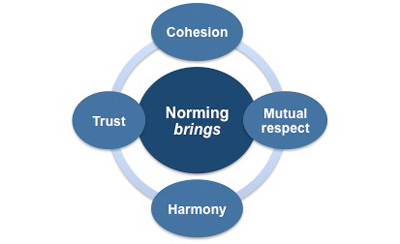 |
Team members are learning more about each other and how they will work together and are developing tools such as a problem-solving process, a code of conduct, a set of team values, and measurement indicators. The team has now established core processes, and as manager you need to ensure the team avoids spending unnecessary time on issues related to the smaller processes.
During this period of negotiation and discussion, your role becomes one of observer and facilitator in order to assist your team in establishing the ground rules of behavior as they learn to work together. Their attitudes are characterized by decreasing animosities toward other members; feelings of cohesion, mutual respect, harmony, and trust; and a feeling of pleasure in accomplishing tasks.
Your team is truly developing a sense of team pride, and you will see evidence of increased productivity as skills develop. The team arrive at decisions that are more in line with their purpose rather than from a position of compromise.
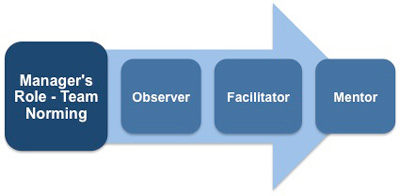 |
You can begin to transform your role as coach to one of a mentor and delegator, offering your team greater opportunities to raise their levels of expertise.
Stage 4 - Performing
Now your team has reached the final stage of its development and can now bring real benefits to you and the organization. Your team members are now competent, autonomous, and able to handle the decision-making process without supervision.
Your team has been accomplishing work at every stage, but it is at this 'performing' stage that work is accomplished most effectively. Morale is high and the general atmosphere is positive. Team members' attitudes are characterized by positive feelings and eagerness to be part of the team.
Members are confident about the outcome, enjoy open communication, exhibit high energy, and disagreement is expected and allowed as long as it is channelled through means acceptable to the team. Leadership within the team is often shared and tasks are delegated within the team, which makes the overall decision-making process operate more easily than at earlier stages.
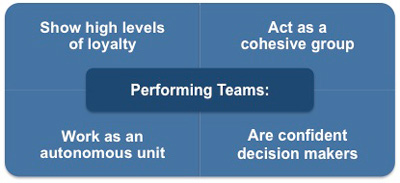 |
As a manager, once your team is operating at this level then your role becomes one of overseer and delegator. You are no longer involved in day-to-day activities and the team's relationships with each other emulate the high degree of trust and loyalty you show in your relationship with the team.
Another key task you will perform at this stage is one of monitoring your team's relationships and performance to ensure that the group dynamics remain positive and productive. This is because changes in the dynamics of the group can result in high-performing teams reverting to earlier team-building stages.
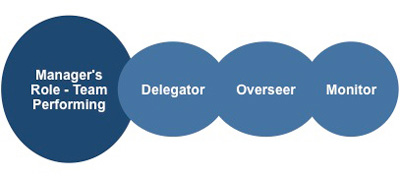 |
For example, a change in leadership may cause the team to revert to 'storming' as the new people challenge the existing norms and dynamics of the team.
Whilst Tuckman's model has been extremely influential in terms of improving peoples' understanding of how group dynamics change as a team becomes a cohesive group, it is not readily transferable to the world of work.
In the more than fifty years since Tuckman's research many others have related group dynamics to the place of work. It is the model of J. Richard Hackman that is frequently referred to when one is responsible for designing and managing work groups. This Team Development Checklist shows you the behaviors your team requires you to exhibit during its four-stage development.
You may also be interested in:
How to Motivate Your Team | Bruce Tuckman's 'Stages for a Group' Theory | Richard Hackman's 'Five Factor Model'.



